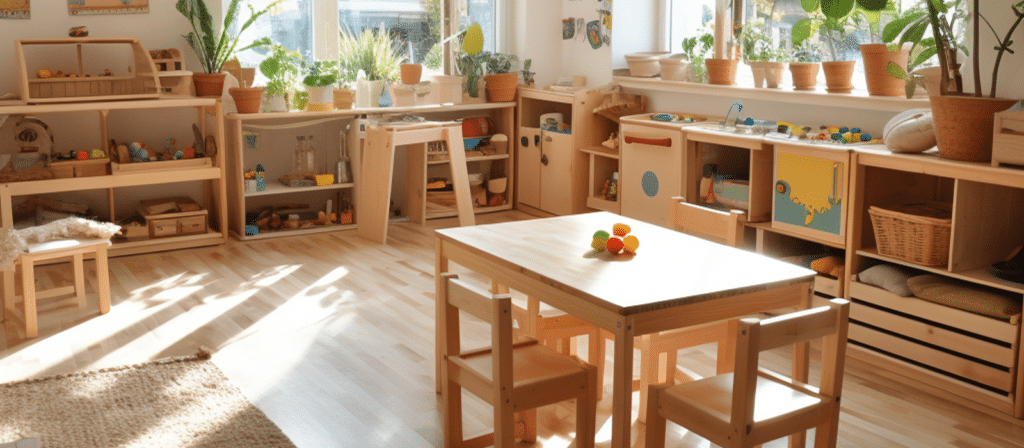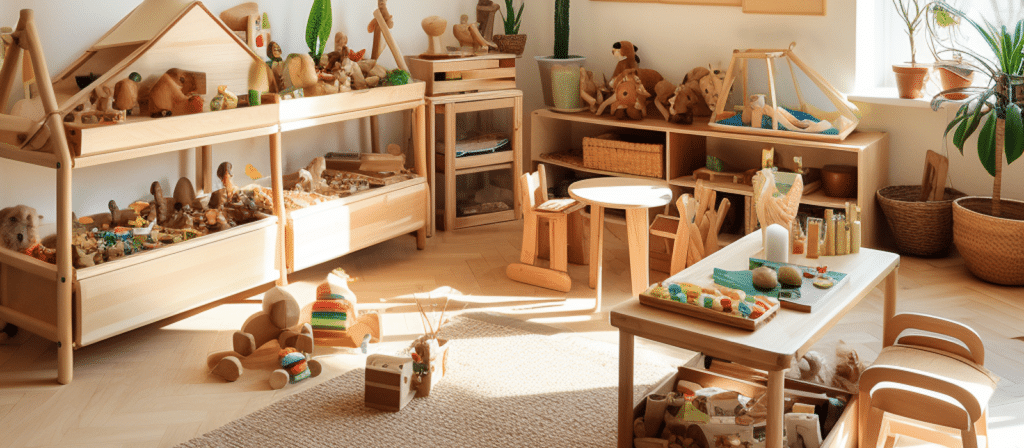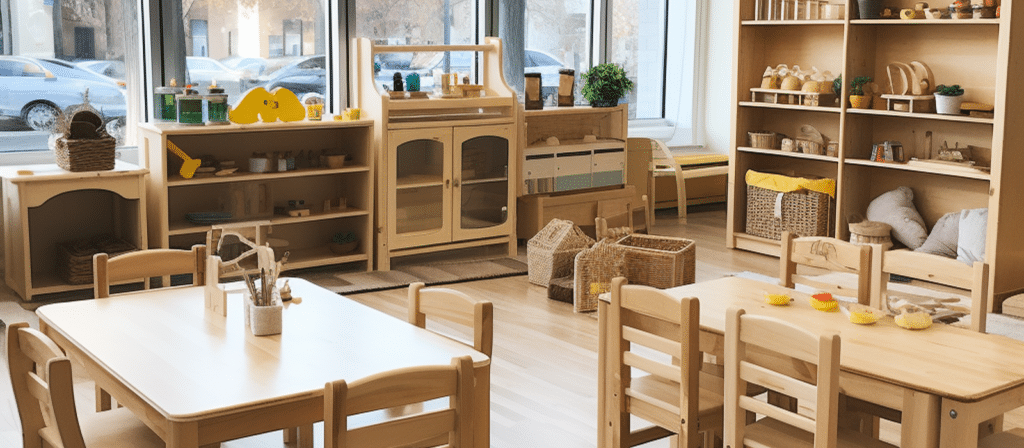Have you ever wondered how to ignite your child’s curiosity and appreciation for the natural world? Join us on a journey as we explore the enchanting world of Reggio Emilia-inspired Nature Tables. These captivating spaces invite children to interact with the wonders of nature, fostering creativity, inquiry, and a deep connection with the environment.
Creating a Reggio Emilia Nature Table: Furniture and Natural Treasures is a delightful endeavor that combines the right furniture and a curated selection of natural elements to inspire young minds. By bringing a touch of the outdoors indoors, you can spark children’s imaginations, encourage exploration, and promote a lifelong love of nature.
What exactly is a Reggio Emilia nature table?
Simply put, it is a dedicated space within the classroom or home environment where children can explore and engage with a variety of natural materials. The purpose of the nature table is to stimulate curiosity, promote sensory exploration, and inspire creativity. It is a place where children can connect with the natural world, fostering a deeper understanding and appreciation for the environment around them.
Why is a nature table important?
A nature table provides children with a sensory experience that engages their senses and encourages exploration. It allows them to connect with the natural world, fostering a sense of wonder and appreciation for the environment. By interacting with natural materials, children develop their fine motor skills, creativity, and problem-solving abilities. Additionally, a nature table promotes a sense of calm and mindfulness, creating an inviting and peaceful atmosphere.

Now, you might be wondering how to set up a Reggio Emilia nature table. Well, the furniture plays a crucial role in creating an inviting and functional space. One key piece of furniture is a low table, preferably made of natural materials such as wood. This table should be at a height that allows children to comfortably explore and interact with the items on display. It should also have a sturdy construction to withstand the daily wear and tear of enthusiastic little hands.
In addition to the table, seating options are important to consider. Cushions or small stools made of natural fibers provide comfortable seating for children as they engage with the nature table. These seating arrangements can be easily moved around to accommodate different activities and group sizes.
How to create a Reggio Emilia nature table?
Creating a Reggio Emilia nature table is a simple and enjoyable process. Here are some steps to guide you:
- Choose a dedicated space: Select a table or a low shelf that can be easily accessed by children. Ideally, the table should be placed near a window to allow natural light to shine on the materials.
- Gather natural materials: Collect a variety of natural materials such as stones, seashells, pinecones, acorns, leaves, and feathers. Encourage children to collect these treasures during nature walks or outdoor explorations. Remember to sanitize and inspect the materials for safety before placing them on the table.
- Arrange the materials: Arrange the natural materials on the table in an inviting and aesthetically pleasing manner. Consider using baskets or trays to organize the items and create different sections for each type of material. You can also incorporate magnifying glasses, tweezers, and small containers for further exploration.
- Rotate the materials: Keep the nature table dynamic by regularly rotating the materials. Introduce new items based on the seasons, themes, or the children’s interests. This ensures that the table remains engaging and sparks curiosity.
- Observe and document: Encourage children to observe and document their findings on the nature table. Provide sketchbooks, journals, or cameras for them to record their observations and create art inspired by the natural materials. This documentation can be used for further discussions and learning opportunities.

Incorporating nature-inspired furniture
Now that we have covered the furniture aspect, let’s move on to the natural treasures that can be incorporated into a Reggio Emilia nature table. The possibilities are endless, but here are some ideas to get you started:
- Rocks and Minerals: Collect a variety of rocks and minerals of different shapes, sizes, and textures. These can be arranged in a visually appealing manner, encouraging children to touch and explore the unique features of each specimen.
- Shells and Seashore Treasures: Bring the wonders of the ocean to the nature table by including seashells, sea glass, and other treasures found along the seashore. These items can spark conversations about marine life and the importance of protecting our oceans.
- Leaves and Plants: Encourage children to bring in leaves, flowers, and branches from their outdoor explorations. These natural elements can be displayed in vases or arranged on the table, providing an opportunity for children to observe and compare different types of foliage.
- Feathers and Bird Nests: Bird feathers and nests are fascinating natural artifacts that can ignite children’s curiosity about birds and their habitats. Displaying these items on the nature table can lead to discussions about bird species, migration, and the importance of conservation.
- Pinecones and Seeds: Explore the wonders of nature’s reproductive cycle by including pinecones, seed pods, and various types of seeds on the nature table. Children can examine the shapes, sizes, and textures of these natural treasures, and even experiment with planting them to observe growth and development.
- Sea Creatures and Fossils: If possible, consider adding replicas or models of sea creatures and fossils to the nature table. This can spark discussions about prehistoric life, evolution, and the interconnectedness of all living beings.
By incorporating these natural treasures into the Reggio Emilia nature table, we create a rich and stimulating learning environment that encourages hands-on exploration and inquiry-based learning. It provides children with opportunities to develop their observation skills, engage their senses, and deepen their understanding of the natural world.

The benefits of a Reggio Emilia nature table
A Reggio Emilia nature table offers numerous benefits for children’s development and learning:
- Connection with nature: By interacting with natural materials, children develop a deeper connection with the natural world. They learn about different textures, colors, and patterns found in nature, fostering an appreciation for the environment.
- Sensory exploration: The varied textures, scents, and sounds of the natural materials stimulate children’s senses, enhancing their sensory development and awareness.
- Fine motor skills: Manipulating and arranging the natural materials on the nature table improves children’s fine motor skills and hand-eye coordination.
- Creativity and imagination: The open-ended nature of the materials on the table encourages imaginative play and creative thinking. Children can use the items to build, create artwork, or invent stories.
- Scientific inquiry: The nature table provides a platform for scientific inquiry and exploration. Children can observe and investigate the properties of the materials, leading to questions and discussions about the natural world.
Conclusion
The creation of a Reggio Emilia nature table is a wonderful way to bring the beauty and wonder of nature into the learning environment. Through carefully selected furniture and a variety of natural treasures, we can inspire children’s curiosity, foster their love for the environment, and ignite a lifelong passion for learning. So, let’s embrace the Reggio Emilia approach and create a nature table that will captivate and engage young minds.










